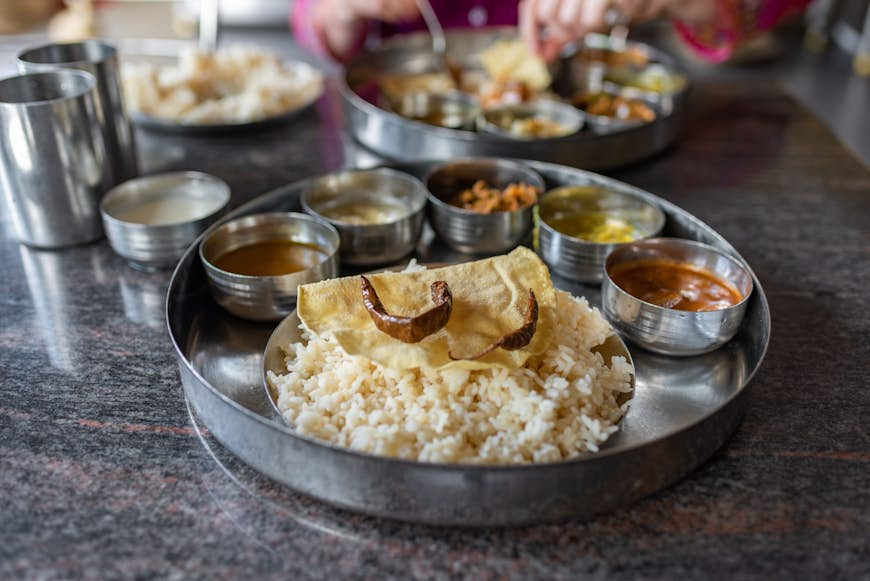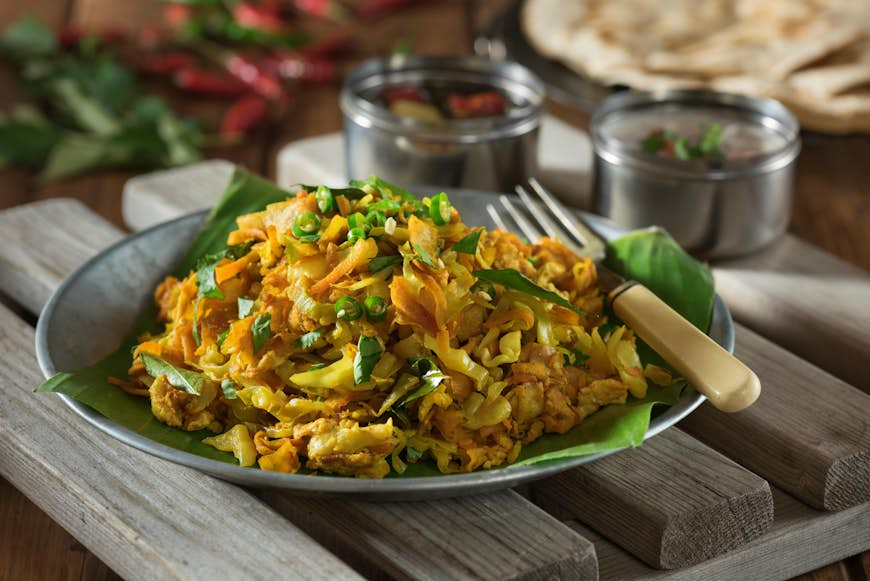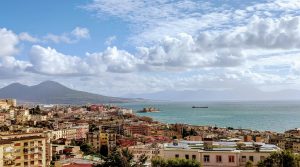
A melting pot of Indian, Southeast Asian, and Arabic flavors as well as colonial influences, Sri Lankan cooking is a feast for the senses, drawing on incredibly fresh herbs and spices and the bounty of the land and sea.
Eating out in Sri Lanka is a delight, whether you tuck into authentic rice and curry at a roadside cafe, dive into a plate of kottu (chopped roti flatbread with vegetables and meat) at a downtown hole-in-the-wall or sample surf-fresh seafood at a swish oceanfront restaurant.
Munch down where the locals eat to enjoy Sri Lankan food at its most fiery and full-flavored. Here are the best things to eat and drink in Sri Lanka.
Get trusted guidance to the world’s most breathtaking experiences delivered to your inbox weekly with our email newsletter.
Munch on Sri Lankan hoppers
Made with a fermented batter of rice flour and coconut milk, hoppers – also known as appa or appam – are bowl-shaped pancakes with crispy edges and fluffy centers. Plain hoppers usually come with the chili and salt condiment lunu miris. Follow up with a savory egg hopper – chefs crack open an egg into a plain hopper and tip it off the skillet perfectly cooked. Hoppers also come with sweet milk or jaggery (palm sugar) and coconut milk, making quite the dessert.
Where to try it: Visit roadside hopper stalls for an inexpensive Sri Lankan meal. For a gourmet experience, reserve a table at the fine-dining Palmyrah Restaurant in the Renuka City Hotel.
Devour string hoppers with curry
Don’t let the name fool you – idi appa or idiyappam (string hoppers) are entirely different from ordinary hoppers. Often served for breakfast, these steamed rice flour noodles are hand-pressed into thin, delicate mats. No idi appa meal is complete without a side of pol sambol (grated coconut pounded with chili) and a creamy dal curry, cooked in thick coconut milk, scented and flavored with cinnamon and curry leaves.
Where to try it: Culture Colombo has a tasting basket that comes with hoppers, string hoppers, condiments and curry dishes. It’s a perfect way for first-timers to get a taste of Sri Lankan breakfast and dinner items.
 Rice and curry is the fuel of Sri Lanka © Malcolm P Chapman / Getty Images
Rice and curry is the fuel of Sri Lanka © Malcolm P Chapman / Getty Images
Feast on rice and curry whenever you get the chance
This everyday staple is an umbrella term for a broad family of complex, intricately-spiced vegetable (and often meat and fish) dishes, served with rice – a bit like an Indian thali. A meal might consist of half a dozen curries, with at least one based on meat, poultry, fish, seafood or egg, and one made from dal (lentils). On the side, pickles, chutneys and pol sambol add extra heat. There’s also mallung, a leafy salad made with green leaves, chopped green chili, onions, and grated coconut.
Most Lankan curries are based on coconut milk, with a blend of spices – including but not limited to chili, turmeric, cinnamon, cardamom, coriander, lemongrass, rampe (pandanus leaves), curry leaves, mustard, and tamarind.
Dried Maldive fish – cured, dried tuna, produced in the Maldives – is also frequently used as a seasoning. Chicken is common, along with mutton, plenty of beef dishes, spicy pork curries cooked with black pepper and abundant vegetable dishes.
As you travel around the country, you’ll often have occasion to pull over at a local restaurant for a rice and curry feast. Some of the best places are simple family-owned restaurants by the roadside, offering a daily selection of meat, fish, and veg dishes (sometimes with as many as 10 choices). It’s a vastly more exciting introduction to Sri Lankan cuisine than eating at a tourist restaurant where the spices are toned down.
Many restaurants only serve rice and curry at lunchtime. Guesthouses will often prepare it for dinner but you’ll need to order it earlier in the day to give cooks time to work their magic.
Where to try it: Laid back, popular and with big flavors, the rice and curry from Mettha’s Home Cooked Meals Traditional Sri Lanka Restaurant in Unawatuna tastes gratifyingly similar to the food prepared in Sri Lankan homes. Otherwise, head to the Galaxy Lounge in Arugam Bay where the rice and curry is so good that the Sri Lankan cricket team came back for seconds.
 Kotthu (chopped fried flatbread) is Sri Lanka’s favorite street food © Simon Reddy / Alamy Stock Photo
Kotthu (chopped fried flatbread) is Sri Lanka’s favorite street food © Simon Reddy / Alamy Stock Photo
Sit down for a plate of kotthu
A spicy mishmash of leftover flatbread, fresh vegetables, egg and meat, kotthu is the island’s dinnertime favorite. This carb-heavy, popular hangover cure comes with a rhythmic soundtrack as the ingredients are chopped on a hot metal griddle with two metal blades.
This hard-to-miss metal-on-metal sound keeps the streets alive at night. Listen closely and you’ll notice that kotthu chefs all have their own, distinctive rhythm as they chop the ingredients. Chicken and pork kotthu are popular, but seafood versions with fish, crabs or prawns are easy to find in coastal regions.
Where to try it: For locals, Hotel De Pilawoos in Colombo is an all-time favorite. If you find yourself upcountry, grab a plate of kottu from Themparadu in Nuwara Eliya. Add cheese if you like your kotthu oily, and finish off with a glass of chocolate-flavored iced Milo.
Snack on isso vadai at Galle Face Green
Crispy, crunchy and slightly spicy, isso vadai is a fixture of Galle Face Green in Colombo, with a dozen or so vendors dotted around this open green in the city center. These deep-fried lentil-and-prawn fritters are the perfect snack to munch as you watch the sunset and listen to the hubbub of this bustling city. Here, it’s served with onion chutney unlike elsewhere in the country.
Where to try it: Galle Face Green is the prime spot to try isso vadai, but you can also grab some from the vendors you’ll meet on trains or buses across the country. You’ll also find parippu vadai, made without prawns.
 Pol roti – a kind of flatbread with coconut – is a popular Sri Lankan breakfast © RUBEN RAMOS / iStockphoto / Getty Images
Pol roti – a kind of flatbread with coconut – is a popular Sri Lankan breakfast © RUBEN RAMOS / iStockphoto / Getty Images
Start your day with pol roti
Toasted and sometimes slightly charred, pol roti is a Sri Lankan flatbread made with flour and grated coconut. This breakfast or dinner item often comes with a side of lunu miris (a condiment made from chili and salt) and a spice-laden chicken curry.
Note that pol roti is different from the flour-only ‘roti’ often served at tourist-oriented restaurants and beach shacks across the country; be sure to stop by a local family-run place for the real deal.
Where to try it: For a pol roti meal in Colombo, drop in at the ever-popular Culture Colombo. Not far away is The Cauldron, a charming cafe that dishes up kotthu made with pol roti.
Go for a lamprais brunch on Sunday
Meticulously wrapped and baked in banana leaves, lamprais has its roots in the Burgher community in Sri Lanka, a minority ethnic group of mixed Sri Lankan and Dutch descent. This slow-cooked Sri Lankan packed lunch contains an enticing amalgam of ingredients.
Inside the banana-leaf wrapper, you’ll usually find rice, a mixed meat curry (which may include chicken, pork, beef or mutton), frikkadels (spicy meatballs), blachang (a dried prawn paste spiced with pepper and garlic), seeni sambol (a caramelized sweet-spicy onion relish) and brinjal pahi (pickled eggplant). Some Burgher kitchens also include an ash plantain curry.
Don’t just order the first lamprais you see, as it could be far from its authentic best – seek it out at cafes that specialize in the dish.
Where to try it: As the number of Burghers has dwindled, it has become increasingly difficult to find good lamprais, but Rodrigo’s in Colombo does a satisfying lamprais lunch. They sell out fast so make sure you order ahead. Another good spot on Sunday is the VOC Cafe run by the Dutch Burgher Union in Colombo; cool down with a bottle of homemade ginger beer.
Get messy with Sri Lanka’s lagoon crabs
Fat and meaty, Sri Lanka’s lagoon crabs are often sent for export, but a few restaurants and home kitchens in Colombo sell this island specialty. Jaffna crab curry, made with a northern Sri Lankan spice mix and freshly caught mud crabs, packs a punch and is best enjoyed with a plate of white rice.
Where to try it: As the name suggests, Ministry of Crab in Colombo specializes in crabs, including jumbo-sized shellfish that are hard to find elsewhere. Stop by Colombo’s The Fat Crab for a more pocket-friendly experience, or order in from Crab Tales, a delivery kitchen serving homecooked crab curry based on a traditional family recipe from Batticaloa in the island’s east.
 Kiribath, a Sinhalese and Tamil New Year festival food, is now easy to find year-round in Sri Lanka © Dumi Jay / iStockphoto / Getty Images
Kiribath, a Sinhalese and Tamil New Year festival food, is now easy to find year-round in Sri Lanka © Dumi Jay / iStockphoto / Getty Images
Tuck into Sri Lankan kiribath
Kiribath is the island’s celebratory dish, meaning people cook it on all special days (think New Year, weddings, the first day of a job or college). Made with traditional Sri Lankan kekulu rice cooked in thick coconut milk, kiribath is cooled down on banana leaves or a flat griddle, compressed and cut into diamond-shaped blocks before serving.
At home, locals often devour this specialty with a spoonful of lunu miris chili paste or katta sambol (a variation with onion and Maldive fish) – both are fiery, spicy accompaniments. Finish off any meal with a slice of kiribath with jaggery (palm sugar) or banana for the perfect sweet kick.
Where to try it: Many restaurants now serve kiribath every day of the week. Drop in for the breakfast buffet at the refurbished heritage hotel, Cinnamon Bentota Beach, for a feast of kiribath and spicy curries. Upali’s by Nawaloka in Colombo also has kiribath on their breakfast menu.
Sip some local toddy
Toddy is a lightly alcoholic drink made from the sap of palm trees. Fresh toddy is sweet and has a sharp wine-like taste. You can find three types of toddy across the country: one made from coconut palms, one made from kitul palms, and a third made from palmyra palms. The latter is most popular in northern Sri Lanka, where palmyra palms dominate the landscape.
Although toddy shacks are found throughout the country, they are very much a male preserve. Toddy is best enjoyed fresh off the tree with a side of boiled tapioca (the starch from cassava root) served with katta sambol.
Where to try it: For an immersive coconut toddy experience, contact Ceylon Arrack for a tour of one of their estates in Naththandiya, north of Colombo. Not only you will get to sip toddy, you can watch skilled tappers shimmy up the trees to “tap” the coconut flowers for sap.
Grab an arrack cocktail
Arrack is a fermented and (somewhat) refined toddy. Coconut arrack – the most popular drink – is fresh, clean, and coconutty, and similar to a blend of rum and whisky. To make arrack, fermented toddy is distilled into a liquor, then watered down and aged in wooden vats. Local alcohol shops called ‘wine shops’ will mostly have cheaper blends of arrack but you can get a bottle of unblended coconut arrack at any supermarket.
Where to try it: A local favorite, the appealing ColomBar at Cinnamon Lakeside Colombo has an extensive list of arrack cocktails developed by local mixologists. Try the Lantharauma, a ginger-and-tamarind-infused cocktail with coconut arrack served in a hanging lamp. Here, you can also drink arrack neat or sip on palmyra arrack cocktails that are otherwise hard to find.
Slurp some kola kanda
Green, thick and slightly bitter, kola kanda is every Sri Lankan kid’s nightmare as mothers pour a glass of this drink every morning before school. But ask a local and they will tell you how they began to slowly love it as they grew up. This breakfast-only, smoothie-like drink is made with green herbs, rice and coconut milk. It’s best enjoyed warm with a piece of jaggery.
Where to try it: You’ll come across kola Kanda carts on busy streets in the mornings. If you want a sit-down experience, Upali’s by Nawaloka in Colombo is the place to go.
 Sri Lanka’s markets are piled high with fresh vegetables that are made into curries and salads © eFesenko / Shutterstock
Sri Lanka’s markets are piled high with fresh vegetables that are made into curries and salads © eFesenko / Shutterstock
Vegetarians and vegans
It might come as a surprise, but Sri Lanka is a great destination for vegetarians and vegans if you stick to vegetable-based curries cooked in coconut milk and vegetable kotthu. Vegans may need to explain their requirements as many dishes contain ghee (clarified butter), shrimp paste, dried fish or milk.
Most tourist-catered cafes and restaurants now serve coffee with vegan-friendly alternatives such as soy, almond or coconut milk. Stop by Cafe Kumbuk in Colombo for vegetarian and vegan-friendly dishes made with a local twist; their jackfruit tacos are extremely more-ish.
Outlets of the government-backed Hela Bojun chain, entirely run by women, are scattered across the country and they serve great, inexpensive local fare incorporating regional ingredients, with many vegetable choices. Koha Surf Lounge in Unawatuna is great for vegans while Life’s Good Kitchen in Colombo whips up fabulous vegetarian-friendly meals.
Foods worth trying
Hot Butter Cuttlefish: Crunchy flour-coated cuttlefish tossed with butter, spring onions and chili; it makes a great snack, especially with a glass of Sri Lankan Lion beer. Available in every beachside restaurant.
Village buffalo curd: Sri Lanka’s go-to dessert, traditional village buffalo curd comes in clay pots and is traditionally topped with sweet, earthy kithul palm treacle. Goodfolks in Colombo sells kithul palm treacle in bottles.
Lavariya: Rice noodle pockets stuffed with a caramelized coconut filling that’s delicately spiced with nutmeg and cardamom. This teatime snack is served warm with a glass of ginger-infused tea, and it’s easy to find in village restaurants and shops.
 Sri Lanka’s colorful festivals come with equally colorful festival foods © Val Shevchenko / Shutterstock
Sri Lanka’s colorful festivals come with equally colorful festival foods © Val Shevchenko / Shutterstock
A year in food
You’ll never be short of flavourful food in Sri Lanka, but some dishes and experiences are seasonal, often tied to the island’s cultural and religious festivities.
January
Stop by a Hindu temple during Pongal (a Hindu harvest festival celebrated by Tamils) for a plate of sweet pongal, a rice porridge made with raisins.
April
Sweetmeats and snacks such as kevum (golden, deep-fried rice cakes), kokis (deep-fried turmeric-colored rice-coconut milk snacks) and dodol (coconut milk-based, pudding-like dessert made with jaggery) show up in every household during the Sinhala and Tamil New Year in mid-April.
April-May and/or July (during Eid)
To celebrate Eid, Muslim families in Sri Lanka prepare a coconut custard called watalappan sweetened with jaggery and topped with cashews for extra crunch.
May–June
On full moon days in May and June – holidays which carry special religious significance for Buddhists in the country – you’ll come across makeshift roadside stalls serving free food, a tradition known as dansel. The free treats may include ice cream, fresh juice, rice and curry, fried rice and boiled corn. Stalls often have long queues but visiting is an experience. Friendly locals may stop and invite you to their dansel, and refusing food is considered impolite — why would anyone say no to free food?
December
Sri Lankans bake “love cake” for Christmas, a nutty semolina cake lightly spiced with cinnamon and nutmeg. Be sure to also sip some thambili wine, a sweet-fresh and warm-spicy drink made with fermented water from king coconuts, the ones with a bright orange husk.



